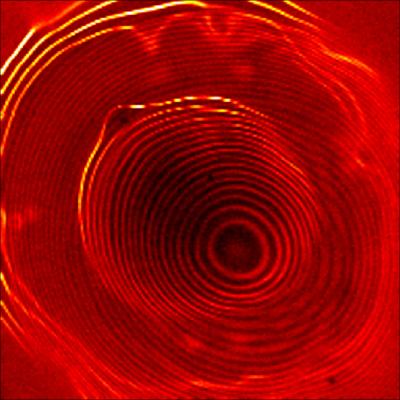Researchers at the National Institute of Standards and Technology (NIST) and their colleagues have used graphene and STM technology to create and image a novel pair of quantum dots â tiny islands of confined electric charge that act like interacting artificial atoms. Such coupled quantum dots could serve as a robust quantum bit, or qubit, the fundamental unit of information for a quantum computer. Moreover, the patterns of electric charge in the island can’t be fully explained by current models of quantum physics, offering an opportunity to investigate rich new physical phenomena in materials.
 a system of coupled quantum dots taken by STM shows electrons orbiting within two concentric sets of rings, separated by a gap. The inner set of rings represents one quantum dot; the outer, brighter set represents a larger, outer quantum dot. Credit: NIST
a system of coupled quantum dots taken by STM shows electrons orbiting within two concentric sets of rings, separated by a gap. The inner set of rings represents one quantum dot; the outer, brighter set represents a larger, outer quantum dot. Credit: NIST
The NIST -led team included researchers from the University of Maryland NanoCenter and the National Institute for Materials Science in Japan. The team used the ultrasharp tip of a scanning tunneling microscope (STM) as if it were a stylus of sorts. Hovering the tip above an ultracold sheet of graphene, the researchers briefly increased the voltage of the tip.
But when the team applied a magnetic field of 4 to 8 tesla (about 400 to 800 times the strength of a small bar magnet), it dramatically altered the shape and distribution of the orbits that the electrons could occupy. Rather than a single well, the electrons now resided within two sets of concentric, closely spaced rings within the original well separated by a small empty shell. The two sets of rings for the electrons now behaved as if they were weakly coupled quantum dots.
This is the first time that researchers have probed the interior of a coupled quantum dot system so deeply, imaging the distribution of electrons with atomic resolution, noted NIST co-author Daniel Walkup. To take high-resolution images and spectra of the system, the team took advantage of a special relationship between the size of a quantum dot and the spacing of the energy levels occupied by the orbiting electrons: The smaller the dot, the greater the spacing, and the easier it is to distinguish between adjacent energy levels.
In a previous quantum dot study using graphene, the team applied a smaller magnetic field and found a structure of rings, resembling a wedding cake, centered on a single quantum dot, which is the origin of the concentric quantum dot rings. By using the STM tip to construct dots about half the diameter (100 nanometers) of dots that they had previously studied, the researchers succeeded in revealing the full structure of the coupled system.